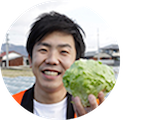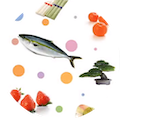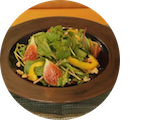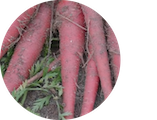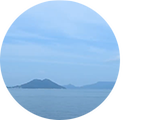
Behind the rainy season, the dazzling summer is waiting. In this season, I would like to send information about Sanuki to deliver a cool breeze. Therefore, I would like to introduce Marugame City, the largest production center in Japan. By the way, in Kagawa prefecture, besides the fan, you can get a nice summer outfit with the yukata of Kirigeta (Sanuki City) and the Botaori (Takamatsu City).
Castle town Marugame has become a new city
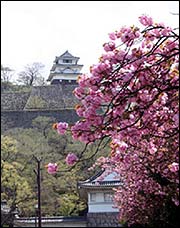
Marugame City is known throughout Japan as the town of Marugame Castle, the Shiotsu Islands, and the fan. It was ruled by Kyokugoku for a long time during the feudal era, and has left a reminiscent of an emotionally rich castle town. In March of last year, the former Marugame city merged with the former Ayauta town where New Reoma World is located, and the former Iiyama town known as Sanuki Fuji for Iinoyama and peach, and started as a new “Marugame city”. . A community bus connects various parts of the city from JR Utazu Station and Marugame Station.
Shikoku is cool with Sanuki fan
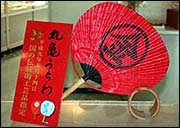
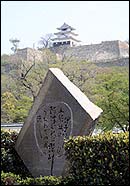
Marugame has long been known as a fan production area in Edo. The fan kingdom still accounts for 90% of the national market share. By the early Edo period, Marugame Uchiwa had already established fan making. The name came to be known all over the country in Kanei 10 (1633), the god of the sea "Konpira-san" known as Konpira Daigogen's bespoke, the priest of Konkoin was a souvenir for Kompira. I figured the round fan of the round gold stamp. Also, during the Tenmei period (1781 to 1788), a Marugame feudal priest who went up to Edo on a part-time job shift learned how to make a fan from the Buzen Nakatsu Domain (now Nakatsu City, Oita Prefecture), whose mansion was next to him. . This spread to the lower part of the castle as the clan's internal employment, and eventually became the local industry of Marugame.
At the moat end of Marugame Castle, there is a song monument saying, "If you go to Iyotake Take Tosa paper and go to Awa, Sanuki fan and Shikoku is cool." It is a folk song with the meaning of being very cool in Ehime bamboo with Kochi paper, and in Aoi-dori, in Kagawa prefecture.
The more such songs were sung, the more Sanuki Uchiwa became known throughout the country.
However, times have changed, and the role of fans has diminished with the spread of electric fans and coolers. Therefore, the people in the fan industry, who were in danger of being blown away by the wind of the times, started various initiatives. Marugame, the town of uchiwa, where a new wind began to blow. What kind of encounters are waiting?
Uchiwa no Port Museum
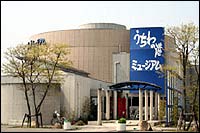
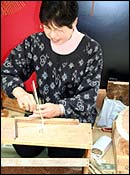
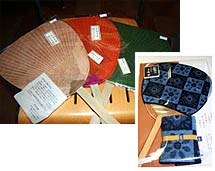
If you want to learn more about Marugame Uchiwa and want to make a souvenir, the "Uchiwa Port Museum" is located right next to Marugame Port. A panel introducing the history of Marugame Uchiwa and valuable tools are on display, and you can enjoy learning about the types of Uchiwa fans. In addition, you can watch a demonstration of making a fan. This is a facility such as the Marugame Uchiwa General Museum, but the admission is absolutely free.
The process of Marugame Uchiwa is divided into 47 parts. In addition, since fan making has evolved as an industry, it is said that there are few skilled craftsmen who can handle this process from beginning to end. Then, in 9, following the fact that it was designated as a national traditional craft, a successor development project began. For training to pass on this valuable technology, veterans who have been building fans for decades have also applied, and have re-learned making fans from scratch.
And new ideas came out one after another, and unique fans came out. You can find these products in the souvenir corner of the museum. Marugame Uchiwa with various ideas. You'll be able to meet the works that make you feel so good.
Inquiries: Uchiwa Port Museum
Phone 0877-24-7055
Tasuke and Noboru
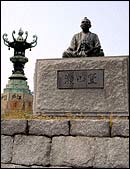
Walking from the "Uchiwa no Port Museum" toward JR Marugame Station, there is a small park in the port nearby and there is a stone lantern just looking up. This is called "Tasuke Lantern", a remnant lantern that was extremely busy as a port town of Konpira during the Edo period. With this as a landmark, many people landed at this port. The largest donation to this large lantern was made by Tasuke Shiobara of Edo, and this lantern came to be called the "Tasuke Lantern".
Noboru Seyama, the statue sitting on that side, played a role in the Marugame clan's Edo morimori who made a great contribution to the spread of Marugame fans. He learned how to make fans from the Nakatsu clan and spread it as a samurai's internal employment. Surprisingly, this person also maintained Marugame Port. With the opening of this port called "Shinbori-tanpo", the number of people using Marugame Port doubled, and those people purchased Marugame's fan as a souvenir for Konpira-san. Thanks to Seyama, Marugame Uchiwa became the best in Japan.
Delicious fish from the salt-waste islands
Currently, there are not as many seaports to Honshu from Marugame Port as in the Edo period. Most of the boats that go and go are by sea to the islands that float in the Seto Inland Sea. Important passenger ships and ferries arrive and depart for the islands called the Shiatsu Islands. The largest of these islands is the main island, 35 minutes by boat from Marugame Port.
Main island fishery cooperative center
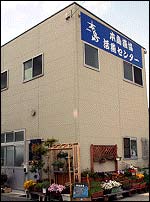
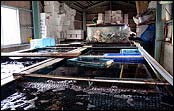
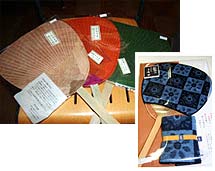
One of the main features of the main island is that the landed Seto Inland Sea fish is delicious. The main island seafood center sells such seafood from the main island. However, this center is not located on the main island but at Marugame Port. Opened in XNUMX, this center is a store for fishermen on the main island. Fresh fish caught in the salt-saturated sea are swimming around in the cave.
We also sell prepared dishes prepared by our chef, who is proud of his skill. You can also rent the second floor and enjoy the fresh fish of the main island. Here is a reservation system, one group per day, from 2 to 5 people. It seems that it will respond to various selfish orders with dishes from 30 yen.
Not to mention the deliciousness of the fish, the attraction here is that you can also touch the people of the island. The manager, who responded to the interview, enthusiastically said, "I want you to eat delicious salt-saturated fish so that you don't have to fish alone." If you visit here, you will definitely want to cross the main island.
This cage is very popular with children and you can buy fish caught in front of you. You ate the fish you picked up yourself, and the taste was better. Seasonal seafood is lined up, but in summer, white fish such as flounder and octopus are popular. We also accept orders over the phone, so please consult us if you want to get fresh Seto fish.
Inquiries: Main Island Fishery Cooperative Live Fish Center 0877-23-8998
Live fish dishes very popular with locals
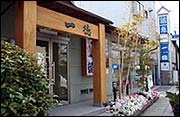
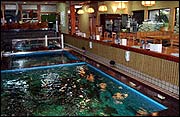
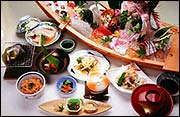
Next, I will introduce another shop related to the main island. Ichitoku is a live fish restaurant just north of the Uchinawa Port Museum. The owner here is a person who knows the local fish that he was a fisherman on the main island. And he still fishes himself. That's why they can offer gorgeous live fish dishes at reasonable prices.
When you enter the shop, there is a large and open cave in the middle of the shop, and 20-30 species, 00 large and small fresh seasonal seafood are always available. Fresh and freshly cooked fish and shellfish dishes with a satisfying taste and price. Lunch time is full of locals every day.
Summer recommendations are sea cucumber and live octopus. The popular menu throughout the year is Chinu Meshi, a local dish. In the evening, it is a luxurious and affordable recommended course dish from 3,150 yen. The dish in the photo is a Setouchi course for 4,200 yen. Menu items include appetizers, pre-applied foods, grilled dishes, boiled dishes, tempura, vinegar dishes, chicken stuffed rice, soups, and luxurious boats. In Marugame, there are many casual restaurants, izakayas, and historical restaurants, as well as many such delicious fish restaurants. Please enjoy the Seto feast.
See the best stone wall in Japan
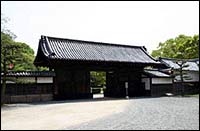

Looking up south from Marugame Port, you can see Marugame Castle, the symbol of Marugame City. This time I will head to Marugame Castle. Marugame Castle was built in 1597 (Keicho 2nd year) by Ikoma Chikamasa, the lord of Sanuki. The castle was temporarily abolished by the Order of One Country in 1615, but the feudal lord of the Yamazaki family rebuilt it and later became the residence of the Kyogoku family. If you walk along the street in front of the city hall, you will see the Ote-Ninomon beyond the moat. When you enter here, you will soon see the majestic gate of Oteichi. The main gate and castle tower are designated as important cultural properties of the country. If you proceed from the first gate, you will see the palace gate of the cultural property designated by the prefecture next.
Go to the left and you will find the fan workshop. You can see the beautiful stone wall when you go up the reward slope that runs from the side. This stone wall is called "fan mating" because of its curving, and is said to be the most beautiful in Japan. The four-layered stone wall from Uchibori to the castle tower is about 4 meters high, and this height is said to be the highest in Japan.
Japan's smallest wooden keep
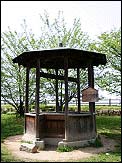
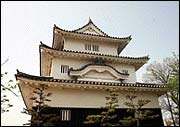
Ascend the hill and go further up to the spacious Ninomaru. This plaza has a well known to be the deepest in Japan. The wells and the stone walls have also been told that the hardship behind the castle was overwhelmed.
And the Marugame Castle tower that comes into view. It is the smallest wooden castle tower in Japan with three layers and three floors. Despite its small size, the designs such as the Kara Gable and the Staggered Gable are beautiful and elegant. The entrance fee is 200 yen, and you can enter the interior. (Closed from December 12 to the end of February). The view is wonderful, and you can see the Marugame plain, Marugame city, the harbor, the main island and the Seto Inland Sea. Please feel free to feel like a lord.
The encouraging ally of this tour is the Marugame Castle Cultural Property Tourist Information Center. On Sundays, you will be waiting under the eaves of the Otemon Gate to provide a volunteer guide in the castle. As the name suggests, the association was established with the Cultural Property Protection Association as its parent, so many members are familiar with cultural properties and are studying castles. We ask at the site or we also accept advance telephone reservations.
Contact: Marugame Castle Cultural Property Sightseeing Guide
Phone: 0877-24-8822
Fan making experience at the fan workshop
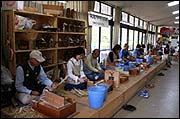
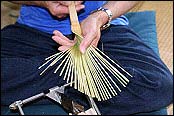
From the gate to the left is Uchiwa Kobo Bamboo. Currently, 13 members who have completed the “Successor Development Project” are voluntarily operated and will also show a demonstration of fan making. The big feature here is that there is an experience classroom. You can also experience paper making and bone making of fan, and you can touch the essence of fan making. The comfort of the blue wind in the only my fan in the world. Production time is less than 30-XNUMX hours. It takes about XNUMX minutes (depending on the weather and seasons) from the time the paper is put on the fan bone until it dries, so it is recommended to take a walk inside the castle. After coming home, you can finish and take it home.
This material costs 800 yen. We also have exhibitions and spot sales, so you can meet elegant, cute and humorous fans. Here is also a tourist information center. Let them know about the highlights of the castle.
One line at a time
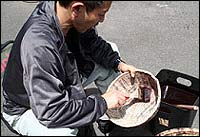
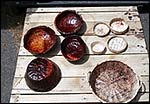
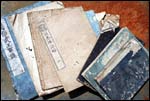
One of the traditional handicrafts from Marugame City that I would like to introduce is "Kozari Zhang". It is said that Kobo Daishi brought back persimmon astringent from Tang country 1200 years ago, and then naturalized person "Hirai Ikkakan" pastes multiple layers of Japanese paper and paints the surface with persimmon astringent It is said to have conveyed the current method. In Marugame City, Ken Nishitani, the fifth generation of Manmitsuan Ikkansai, is certified as a traditional craftsman of the prefecture, and is the son of Ken. Has inherited that technique.
The original name is derived from "Hirai Ikan" and is written as "Ikanbari", but Manman-an has been sticking to "Consistent Chori" for generations. The determination here is to "perform" the traditional methods. Hiroki says that there is a lot of hard work for that. This "penetration" is to stick to the Japanese books of the Edo period.
However, of course, the Japanese book is a valuable thing that is hard to get now. There are treasure booms, and very high prices have been added. In addition, the precious washi must be laid down, lined, and finished, and any small object must be stacked on 60 sheets.
Someday, a Japanese book that you will not be able to get. Mr. Hiroki stated that he would like to try to create "coherence" in an English newspaper for the future.
Even if the material changes, the technique cannot be forgiven. The process is also very time-consuming. The process of drying and drying the secret persimmon astringent is repeated tens of times and hundreds of times. It takes a lot of patience to repeat the shade after painting with a brush. "Kizuhari" is a traditional handicraft crafted by putting Japanese paper on baskets and plates woven from bamboo and applying persimmon astringency. It can be used for generations if used carefully. The simple and chic texture matches casually in today's life. At least once, it's "consistent tension" that you want to pick up.
Inquiries: Telephone Soke consistently Honpo (Hiroki Nishitani)
Phone 090-1176-9962
Local production local consumption udon shop
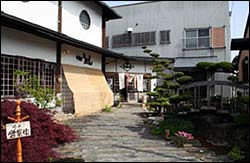
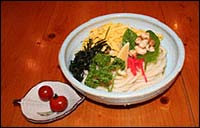
Finally, we will introduce udon shops unique to Sanuki. "Sumiya" of Nakatsu-cho who is certified as a "Sanuki no Yume 2000 specialty store". "Sanuki no Yume 2000 specialty store" is a specialty udon restaurant that provides Udon using Sanuki no Yume 2000, the original wheat grown for Sanuki udon by Kagawa Prefecture, throughout the year. As of June 2006, there are seven specialty stores in the prefecture.
This place not only uses flour, but also focuses on various local ingredients. There is also a section of a direct-production shop inside the shop, and it is also a “Kagawa local production and local consumption cooperation shop”. There are many udon menus using local vegetables, such as aspara curry udon and tomato curry udon, and in the winter, there will also be Hyakka udon using mamba that appears in Sanuki's local cuisine. If you make a reservation, they will also prepare a specialty mini tomato in the neighboring town Tadotsu. Of course, the taste of the noodles themselves has a reputation, and the recommended menu for refreshing noodles in the coming season is "Plum garlic udon". Because we use garlic which does not have to worry about smell, we can easily eat at lunch. Vegetables and soy sauce are also selected from Kagawa Prefecture, and this is the “Sumiya” where you can taste Sanuki udon, which can only be eaten here at local production for local consumption.
Contact: Sumiya
Telephone 0877-22-4320
There are other places in Marugame City that I would like to introduce, such as a museum by a local Western painter, Genichiro Inokuma, in front of JR Station, and a mansion garden with a famous garden and art museum. This summer is Marugame City where you want to take a walk with your fan.
Sightseeing in Marugame City Inquiries: Marugame Tourism Association Phone 0877-24-8816

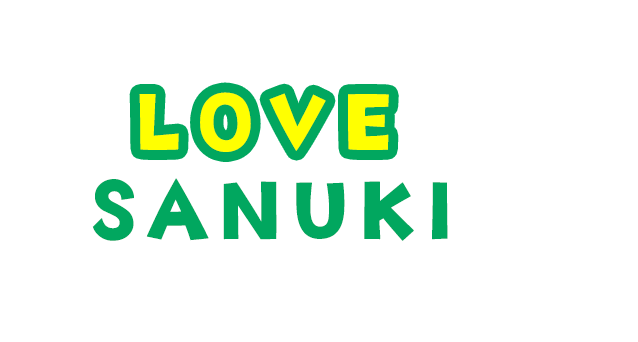














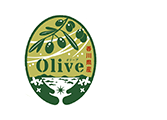 Olive products from Kagawa Prefecture
Olive products from Kagawa Prefecture
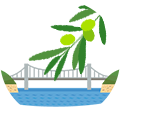
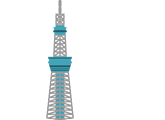
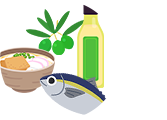
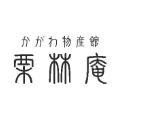
 Stores handling olive-related products
Stores handling olive-related products
